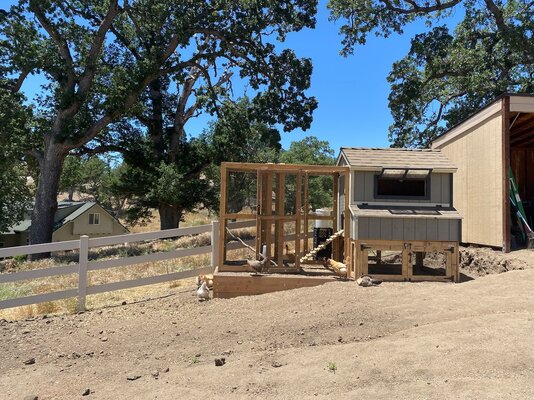- Thread starter
- #11
nicolevg
Songster
Would broccoli stalks, lettuce bottoms and larvae/crickets be considered treats? I don’t really consider them treats, as there are chickens I’ve seen in my research who subside solely on food scraps, seeds and bugs/whatever else they forage.If the entire feather is gone it should start growing back in a few weeks. You should be seeing pin feathers. If any part of the shaft is left that feather will not grow back until she molts. I don't care how much protein you force down them, if any of the shaft is left it will not grow back until she molts. I think that's a big part of what is going on.
Your coop and run are very tight. Any behavioral problems can be made much worse by crowding. Overcrowding can be a cause of feather picking. To me the best boredom buster is giving them plenty of room. Think about your kids. Are they better behaved when they are shoehorned into a small space and left there or are they better behaved when they have more room? Are you seeing feather picking when they are out foraging or when they are cooped up in that tiny run?
It sounds like you have identified one specific hen that is feather picking, quite likely pecking pin feathers as they start to grow back. You can try isolating that hen for a week or so to see if you can break her of the habit of picking feathers. Sometimes that works, sometimes it doesn't.
Regular chicken feed contains all the nutrients and stuff they need for a balanced diet. That's protein, fats, salt, amino acids, fiber, and many other things. They don't need any treats to help them with a balanced diet. But many of us like to give them treats. Mine get kitchen wastes and garden wastes and excess. I toss fruit into them from the orchard. Like yours mine forage for a lot of their food too so I've lost all control over micromanaging their diet. Still I try to not overdo it with the treats. A general rule of thumb on here is that if you limit their treats to about 10% of their daily diet so that the chicken feed is at least 90% of what they eat they maintain that balanced diet. How do you know what makes up 10% of their diet? Another rule of thumb, it's not an exact science. If they can clean up their treats in about 10 to 20 minutes you are good to go. That's daily.
Good luck, these things are not always easy.
And what is considered the needed coop and run space for 10 standard sized chickens? Everything I read online prior to getting chickens said that was sufficient. Plus, we don’t have any more money to spend on expanding the coop and run. These chickens are already wayyyy more expensive than I anticipated, given the increased cost of lumber and building supplies. What should’ve been a $300-500 coop and run for my husband to build ended up being almost triple that.
Their pecking is definitely diminished when they free range, hence why I let them do that. We originally didn’t plan on letting them out much unless we were supervising, but obviously I don’t have the time to sit down there with my chickens and watch them free range for the afternoon and evening hours they’re out on their own. The many foxes, bobcats, mountain lions, bears, hawks and other predators haven’t gotten them yet, so I plan on letting them free range till they start getting picked off. They’re not very friendly birds / are skittish around me still a month later, so I wouldn’t be too upset if I lost several / most of the flock and had to start over again with hatching eggs next spring. I’m thinking having some hens that were raised together since birth might’ve been a better way to go, now that I see how these hens act together. I thought ours were all raised together, but when I went to pick them up, the lady told me she’d only had them in the came flock/coop/run together for the past several weeks and she thought they were doing fine together. Judging by their behavior, I’d say differently. The buffs are super mean to the other hens, and then the other hens become aggressive too trying to defend themselves, so now they’re all aggressive.
They do still peck and chase after each other when free ranging, but not as much as when they’re caged. I’ve noticed some of their feathers are broken, which I know once we fixed till after they molt. But they have lots of little down feathers that come in and then get picked out within a week of coming in.
Last edited:




